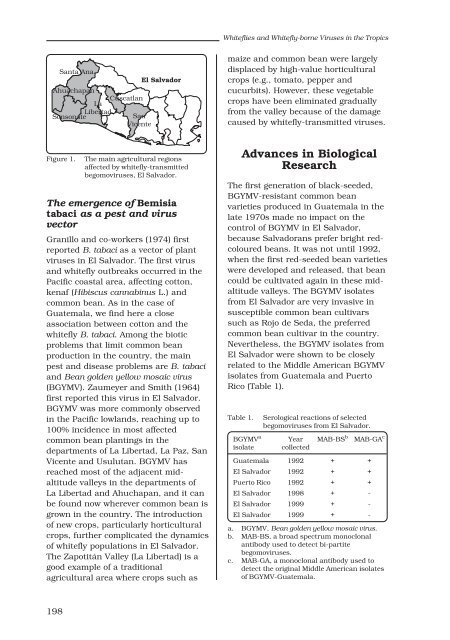Whitefly and whitefly-borne viruses in the tropics : Building a ... - cgiar
Whitefly and whitefly-borne viruses in the tropics : Building a ... - cgiar
Whitefly and whitefly-borne viruses in the tropics : Building a ... - cgiar
Create successful ePaper yourself
Turn your PDF publications into a flip-book with our unique Google optimized e-Paper software.
Santa Ana<br />
El Salvador<br />
Ahuachapan<br />
Cuscatlan<br />
La<br />
Libertad<br />
Sonsonate<br />
San<br />
Vicente<br />
Figure 1. The ma<strong>in</strong> agricultural regions<br />
affected by <strong>whitefly</strong>-transmitted<br />
begomo<strong>viruses</strong>, El Salvador.<br />
The emergence of Bemisia<br />
tabaci as a pest <strong>and</strong> virus<br />
vector<br />
Granillo <strong>and</strong> co-workers (1974) first<br />
reported B. tabaci as a vector of plant<br />
<strong>viruses</strong> <strong>in</strong> El Salvador. The first virus<br />
<strong>and</strong> <strong>whitefly</strong> outbreaks occurred <strong>in</strong> <strong>the</strong><br />
Pacific coastal area, affect<strong>in</strong>g cotton,<br />
kenaf (Hibiscus cannab<strong>in</strong>us L.) <strong>and</strong><br />
common bean. As <strong>in</strong> <strong>the</strong> case of<br />
Guatemala, we f<strong>in</strong>d here a close<br />
association between cotton <strong>and</strong> <strong>the</strong><br />
<strong>whitefly</strong> B. tabaci. Among <strong>the</strong> biotic<br />
problems that limit common bean<br />
production <strong>in</strong> <strong>the</strong> country, <strong>the</strong> ma<strong>in</strong><br />
pest <strong>and</strong> disease problems are B. tabaci<br />
<strong>and</strong> Bean golden yellow mosaic virus<br />
(BGYMV). Zaumeyer <strong>and</strong> Smith (1964)<br />
first reported this virus <strong>in</strong> El Salvador.<br />
BGYMV was more commonly observed<br />
<strong>in</strong> <strong>the</strong> Pacific lowl<strong>and</strong>s, reach<strong>in</strong>g up to<br />
100% <strong>in</strong>cidence <strong>in</strong> most affected<br />
common bean plant<strong>in</strong>gs <strong>in</strong> <strong>the</strong><br />
departments of La Libertad, La Paz, San<br />
Vicente <strong>and</strong> Usulutan. BGYMV has<br />
reached most of <strong>the</strong> adjacent midaltitude<br />
valleys <strong>in</strong> <strong>the</strong> departments of<br />
La Libertad <strong>and</strong> Ahuchapan, <strong>and</strong> it can<br />
be found now wherever common bean is<br />
grown <strong>in</strong> <strong>the</strong> country. The <strong>in</strong>troduction<br />
of new crops, particularly horticultural<br />
crops, fur<strong>the</strong>r complicated <strong>the</strong> dynamics<br />
of <strong>whitefly</strong> populations <strong>in</strong> El Salvador.<br />
The Zapotitán Valley (La Libertad) is a<br />
good example of a traditional<br />
agricultural area where crops such as<br />
198<br />
Whiteflies <strong>and</strong> <strong>Whitefly</strong>-<strong>borne</strong> Viruses <strong>in</strong> <strong>the</strong> Tropics<br />
maize <strong>and</strong> common bean were largely<br />
displaced by high-value horticultural<br />
crops (e.g., tomato, pepper <strong>and</strong><br />
cucurbits). However, Sonora <strong>the</strong>se vegetable<br />
crops have been elim<strong>in</strong>ated gradually<br />
from <strong>the</strong> valley because of <strong>the</strong> damage<br />
caused by <strong>whitefly</strong>-transmitted <strong>viruses</strong>.<br />
Advances <strong>in</strong> Biological<br />
Research<br />
The first generation of black-seeded,<br />
BGYMV-resistant common bean<br />
varieties produced <strong>in</strong> Guatemala <strong>in</strong> <strong>the</strong><br />
late 1970s made no impact on <strong>the</strong><br />
control of BGYMV <strong>in</strong> El Salvador,<br />
because Salvadorans prefer bright redcoloured<br />
beans. It was not until 1992,<br />
when <strong>the</strong> first red-seeded bean varieties<br />
were developed <strong>and</strong> released, that bean<br />
could be cultivated aga<strong>in</strong> <strong>in</strong> <strong>the</strong>se midaltitude<br />
valleys. The BGYMV isolates<br />
from El Salvador are very <strong>in</strong>vasive <strong>in</strong><br />
susceptible common bean cultivars<br />
such as Rojo de Seda, <strong>the</strong> preferred<br />
common bean cultivar <strong>in</strong> <strong>the</strong> country.<br />
Never<strong>the</strong>less, <strong>the</strong> BGYMV isolates from<br />
El Salvador were shown to be closely<br />
related to <strong>the</strong> Middle American BGYMV<br />
isolates from Guatemala <strong>and</strong> Puerto<br />
Rico (Table 1).<br />
Table 1. Serological reactions of selected<br />
begomo<strong>viruses</strong> from El Salvador.<br />
BGYMV a<br />
Year MAB-BS b MAB-GA c<br />
isolate collected<br />
Guatemala 1992 + +<br />
El Salvador 1992 + +<br />
Puerto Rico 1992 + +<br />
El Salvador 1998 + -<br />
El Salvador 1999 + -<br />
El Salvador 1999 + -<br />
a. BGYMV, Bean golden yellow mosaic virus.<br />
b. MAB-BS, a broad spectrum monoclonal<br />
antibody used to detect bi-partite<br />
begomo<strong>viruses</strong>.<br />
c. MAB-GA, a monoclonal antibody used to<br />
detect <strong>the</strong> orig<strong>in</strong>al Middle American isolates<br />
of BGYMV-Guatemala.
















